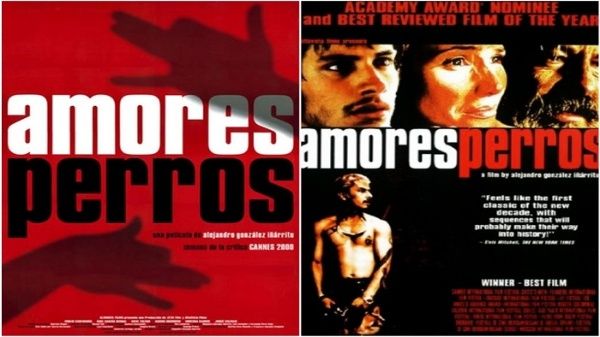
Amores Perros (2000)
Director: Alejandro González Iñárritu
Alejandro González Iñárritu was born in Mexico City in 1965. He is now considered as a remarkable director that delivers passionate cinema, impressive productions and extremely enlightening stories. He focuses on deafening dialogues, overwhelming atmospheres and onslaught violence. Iñárritu possesses a unique seal that delivers the mastery of the brightest and darkest colors of life.
Before becoming involved with cinema, he made the experience of crossing the Atlantic Ocean, when he worked on a cargo ship from 17 to 19 years of age. His trips through the vast and beautiful ocean landscapes allowed him to explore the European and African continents. His work as a filmmaker has been influenced by the experiences he had at the time of traveling through different places around the globe. Also, the films he has made are located in the sites he visited during his nomadic time.
He returned to Mexico City after a long period on the sea, with the purpose of entering the Universidad Iberoamericana. In 1984 he began working as an announcer at the WFM rock station, with a radio program that lasted more than three hours. He set aside his career to devote himself fully to the practice. By 1988, he had managed to become the director of
that radio station, and for five years he was in charge of investigating different musical genres, interviewing important rock personalities like David Gilmour, Robert Plant, Elton John, Bob Geldof and Carlos Santana. Gradually, he made the station grow, making it the number one station in Mexico City for five consecutive years.
After his long journey in radio communication, he retired from the position to dedicate himself to directing some commercial announcements that would start his life as a director. In 1999 he received the opportunity to direct his first and most acclaimed film, entitled Amores Perros, and written by Guillermo Arriaga. This film would form the first part of Iñárritu’s Trilogy of Death.
Amores Perros received mixed reviews upon its release, but it gradually became a national treasure for Mexico City, and a hugely important achievement for international cinema. The film has an extremely cruel, brutal and raw atmosphere, which is highly realistic. It transports the viewer immediately into the underground vessels of Mexico City.
The film exceeds all the highest levels of cinematographic demand or expectations that we can impose on a film. It contains the necessary elements to be more than a great movie: a wonderful script and outstanding performances that are built inside an amazing montage of three stunning stories, that are intertwined by a car accident.
In the first story, we meet the young Octavio (Gael García Bernal). He has the goal to save enough money through illegal, clandestine dog fights, in order to escape his terrible reality and finally live with Susana (Vanessa Bauche), who is the wife of his older brother. Octavio has fallen in love with her.
In the second story, we get to know Daniel (Álvaro Guerrero), an important businessman that dramatically abandons his family to live with Valeria (Goya Toledo), a successful but shallow model. Progressively, Valeria despairs because a serious wound in her leg prevents her from keeping her dog and resume her career as a model.
In the last story, we follow “El Chivo” (Emilio Echevarría). After leaving his family to become a guerrilla, and after serving a sentence in jail, El Chivo returns to Mexico City in search for his daughter Maru (Lourdes Echevarría). El Chivo has now become a hitman, and he has the purpose of saving money for Maru (she just lost her mother). The three stories are intertwined not only by the car accident, but also by the dogs of the protagonists: “Cofi”, “Richie” and “Negro”. They stick to their owners in good times and in bad times.
The most iconic and distinctive symbol of the movie are the dogs. Although the characters have little trust between each other, they all have a deep connection with their pets. Their dogs embody the loyalty that the protagonists should have for their family, or that their family should have for them. Dogs, unlike humans, tend to follow the person who abuses or abandons them. This contrast is well marked throughout the film, because although dogs are victims of humans, they never act aggressively against their owners.
The film also fully recreates the different social classes and their relationships in the city. The costumes indicate the socio-economic situation of the protagonists, as do the locations. El Chivo lives in a poor, old, insecure and dirty neighborhood. Octavio lives in a small, familiar and messy house. Valeria, on the other hand, lives in a luxurious and newly built apartment. The three characters belong to different social classes, and it is not surprising that they do not know each other. They don’t look the same, they don’t have similar jobs and they live in different places. The protagonists do not relate other than through the car accident. The film expresses the social situation in Mexico City in this way; where social classes, although separated, are only connected through the street.
The camera image is unstable and full of gray tones. It exaggerates the violent content and shows open wounds, dead bodies of dogs and outdoor killings. The edition is fragmented, so the narrative does not have a chronological order. The mood embodies the violence and corruption in Mexico City, not only by showing situations of aggression, but also by reflecting this violence in the resources of the image.
The music also plays a very important role in the film. Iñárritu has expressed on several occasions that music has had more influence on him as an artist than films. The soundtrack is packed with several musical genres: rap, cumbia, hip-hop, rock and salsa. The lyrics of the songs manage to represent the feelings and situations experienced by the protagonists. For example, in the song “Lucha de Gigantes” by Nacha Pop, the title makes a reference to violence. It also shows the greatness and power of the city in relation to its citizens. The song “De Perros Amores” also expresses the situation that the protagonists are going through, referring that they seem to be in a constant dream state, in order to avoid the harsh reality of their lives.
Amores Perros represents the murky history of human beings that have lost their paradise, everything they knew and dreamt of has suddenly vanished. However, behind that resignation their memories and their experiences are still alive. The most instinctive, emotional and affective emotions can be perceived in the look of their dogs, which have the ability to turn their dead souls into something pure, incorrupt and innocent.
As Iñárritu pointed out: “Because we also are what we have lost”.
by Octavio Carbajal González

Great film. I haven’t seen it in quite a while. After reading this, I’m going to fix that. Such a good movie.
Gael Garcia Bernal ❤️❤️❤️
Amazing movie, wrote my thesis on it, focusing on the violence in Mexico City and how drastically it’s being depicted in the movie. I know that Mexicans feel a mixture of pride and shame when it comes to this movie. Great cinema.
That´s very interesting, Andreas. A thesis implies a huge development and profound analysis of all the characters, undertones and background of the film. I agree with you, Mexicans have a mixture of pride and shame with this movie… AWESOME pick for your thesis !!
Interesting movie, but very brutal and sentimental, often a bit too much. I think L.A. Crash stole from this…
Cannot wait to jump into this one Vinylwriters. Octavio, your review is fresh and atmospheric giving the reader a glimpse into what should be an exciting experience. So many important films got by me during this period. So glad I have your insights. Thank you.
Thank you for your comment and your special appreciation, Shawn.
When I was a child, I remember my parents telling me that this was going to be the biggest mexican film ever, they also told me about it’s raw, brutal and violent atmosphere. A fierce and brutal representation of Mexico City’s darkest corners, and that’s exactly what it is.
A very special movie, it totally embodies my city of birth… Hope you enjoy the rest of the movies on your list!.
Very violent, the movie is not for everyone, but a masterpiece for me. A great script, excellent camera and cut, as well as excellent actors in a complex structure full of disappointed hopes, love, violence, suffering and profundity. One of the most precious movie jewels! Great review!
Totally agree, it’s a masterpiece. The rawness of the camera work, the mind-blowing script, the insane performances, the complexity of the social/familiar undertones, the parallelisms between humans and dogs… As you said, this movie has everything. Thank you for taking the time to read!.
GREAT movie! It always annoyed me, that this film was compared to Tarantino’s works. But Amorres Perros is nothing about coolness, humor and cool lines, its great narrative cinema about the big things in life, like most of Innarritu’s films. “Biutiful” is my favourite.
I always thought that this movie stands on it’s own, it’s a national treasure for Mexico City.
It has also earned a special place in cinema’s history. Along this years, many other movies have copied it’s narrative style. Thank you for recognizing the movie for what it is, and thank you for highlighting Iñárritu’s work!.
“Biutiful” is my #2 favorite!, Amores Perros takes the big prize.
Thanks for writing about this film, I had almost forgotten about it. ‘Amores Perros’ was a real game changer in 2000, I don’t know how much it holds up to that with another 20 years of cinematic development, and countless other films copying its narrative style. It was quite a hit in the garage/punk scene, a friend from a band had an ‘Amores Perros’ poster in his apartment, that’s were I saw it for the first time. Believe it or not, this friend’s girlfriend was traveling to Mexico back then and just didn’t come back for a couple of months – that was her way of breaking up with him…
Thank you for letting me cover this movie!. Much credit goes to you, Saliha.
Amores Perros is a remarkable achievement that rescued the powerful and boundary-pushing Mexican cinema, a true national treasure.
Regardless of sex, religion or social position, the films shows us the weakest and mightiest side of people; tragedy is the same for everyone.
So happy to see that you were aware of the existence of this movie, it takes you back to your garage/punk years. That’s a truly heartbreaking story, I bet that this movie stuck with your friend…